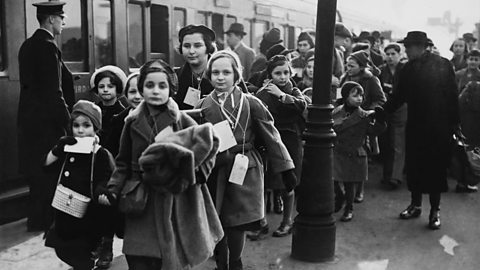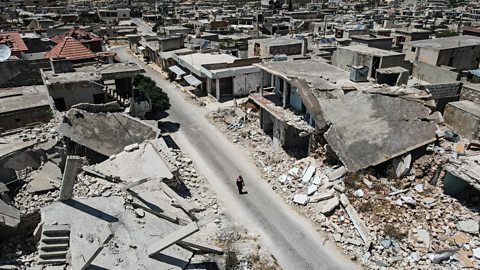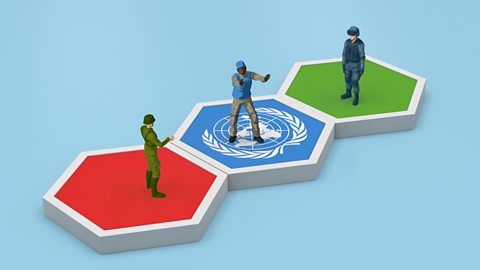What is a refugee?
A refugee is someone who is forced or displaced from their home country as a result of a number of different factors.
They must then seek refuge in other countries. The reasons for someone having to leave their country can be, social, physical or political.
How do people become refugees?
Social factors
Social factors are connected to people’s beliefs and way of life. Many people can be persecutionTreating people poorly based on their political beliefs, race, religion or sexuality. in certain countries on the basis of their religious beliefs. Examples of religious refugees include Muslims persecuted in Myanmar and Hindus in Pakistan.
Sexuality can also be a driving factor in people's decisions to move. Some members of the LGBTQ+ community around the world face sexual and gender-based violence, physical attacks, torture and discrimination.
Physical factors
The most common physical factor that affects populations and causes people to become refugees is the climate.
The increasing effects of climate change mean that more and more areas are facing extreme weather like flooding and tropical storms.
Drought in many countries has made food production unreliable and food shortages and hunger have increased.
Finally, natural disasters like volcanic eruptions, earthquakes and tsunamis can also force communities to leave their homes in search of security, healthcare and shelter.
Political factors
Political factors often relate to the way in which a country is governed and the decisions made that can directly affect its citizens.
Some countries may have a corrupt leadership where decisions are made without putting the wellbeing of its citizens first. This can be through spending money on weapons instead of healthcare and education facilities.
Political disagreements can often lead to wars. Throughout history people have been forced to move because of conflict, either with other countries or through civil wars. This puts people's lives in grave danger and they must flee in order to find safety.
Watch: Refugee video
Watch this short clip to learn more about the reasons refugees are forced to flee.
What do you think of when you imagine a refugee?
Perhaps it’s someone suffering from extreme poverty, or with a very different cultural background or religious beliefs to yourself. But how much is this image shaped by what we see in the media? And what is a refugee, anyway?
A refugee, of course, is a kind of migrant. But while some migrants leave their home voluntarily, refugees don’t have a choice. They’re forced to leave because of circumstances beyond their control. While refugees can be defined fairly simply, the reasons for a refugee crisis can be incredibly complex.
For example, in 2011 Syria was plunged into a deadly civil war – between President Bashar al-Assad and various other factions, both within Syria and outside it, fighting both the Syrian government… and each other.
With such a complex history, you’d think that media portrayals of Syrian refugees would be similarly complex. Unfortunately, that’s rarely the case. And while refugee crises are often the result of war, they are often also the cause of conflict, due largely to media portrayals like these.
What’s often not reported is how refugees can enrich an area, introducing newcultural aspects which could, in time, become part of who we are.
In Wales, the vast majority of local authorities have accepted Syrian refugees since the crisis began. And in that time, many refugee communities have introduced cultural traditions from food to music, while integrating seamlessly into our society – in both English and Welsh.
While civil war and global unrest continue to create refugees, an increasing number are forced to flee their homes for a completely different reason - climate change - and as such become classed as ‘environmental refugees’.
Already, island nations like Papua New Guinea, and coastal areas in Asia andAfrica, are seeing people forced to move inland. Some have even suggested thatunusual levels of drought have contributed to the civil war in Syria.
And the problem is predicted to get much worse. By 2050, it’s estimated that there could be up to 200 million people displaced because of climate change worldwide.
So what do you think of when you imagine a refugee? Someone with a completely different background, from halfway across the world? Or someone a bit closer to home?
Refugees in history
Throughout history, people have been forced to move away from their country of origin, often as a result of religious or racial intolerance. The idea of refugees dates back as far as the ancient Greeks and Egyptians, when an individual could seek sanctuary in a holy place where there would be consequences if they were harmed.
The Second World War caused a huge number of people to become refugees. Estimates suggest that around 60 million Europeans became refugees during this period. The displacement of some groups predated the war, as early signs of Nazi aggression pushed German residents, particularly Jews, to seek safety elsewhere.
Forced migration continued throughout the war. Even within the UK, many children had to leave their families in larger towns and cities, as a result of The BlitzAn aerial bombing campaign directed at large towns and cities and carried out by the German air force (the Luftwaffe) during World War Two., and find refuge in the safety of rural areas. This led to a large influx of children to areas of Wales and Cornwall.

Syrian refugee crisis
The Syrian refugee crisis began in March 2011 and the effects are still being faced years later. Some people in the country had become disillusioned by the rule of President Bashar al-Assad who had succeeded his father as the country's leader. The Assad family first came to power in Syria in 1971.
Many people complained about the lack of freedom they had and the corruption that was happening. Public demonstrations followed and teenagers were arrested for anti-government graffiti.
The government's attempts to suppress these acts fuelled tensions even more and the conflict grew as the country descended into a civil war that forced millions of Syrian people out of their homes.

Other international governments such as Iran, Russia, Saudi Arabia and the USA have become involved in this conflict by providing financial and military support. However these acts have only prolonged and heightened the level of conflict.
In March 2023 the United Nations Refugee Agency said that:
- 14 million Syrians had been forced to flee their homes
- 6.8 million Syrians had been displaced within the country
- 5.5 million Syrian refugees lived in neighbouring countries
Some refugees migrate to Europe illegally. This often involves dangerous methods of travel such as paying smugglers to transport them into countries, either in the back of lorries or in small fishing boats or inflatables which are often overcrowded.
This puts people’s lives in danger. These refugees rarely have any food or water with them and the boats they use are rarely fitted with life rafts. Many who have attempted these journeys have died through suffocation or by drowning.
Management of refugees
Countries across Europe are aiming to help with the refugee crisis. Some countries including Germany and Sweden have welcomed refugees as they are seen as victims and they can be provided with safety whilst also contributing to the countries’ economy.
Other countries such as Austria and Hungary have been less welcoming and have tried to restrict the movement of refugees into their countries. Hungary built a fence along its borders with Serbia and Croatia to reduce illegal migration into the country.
Many countries have argued that welcoming refugees into their country would encourage even more refugees to move there, which the government may not be able to accommodate.
Throughout the crisis, international agreements have been made between countries to deal with the large influx of migrants. The Italian and Greek coastguards have worked together to save many migrants that have attempted to make the journey to Europe across the Mediterranean Sea.
Since the beginning of the crisis organisations like the UN Refugee Agency have been working in Syria to provide shelter, clean water, and medical care to families who have been forced to flee their homes.
More on Conflict and peace
Find out more by working through a topic
- count1 of 3

- count2 of 3
